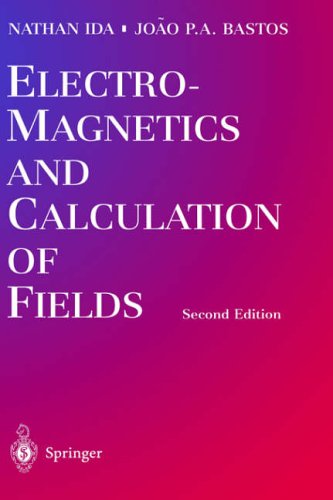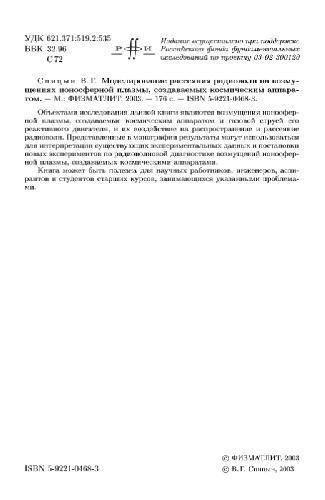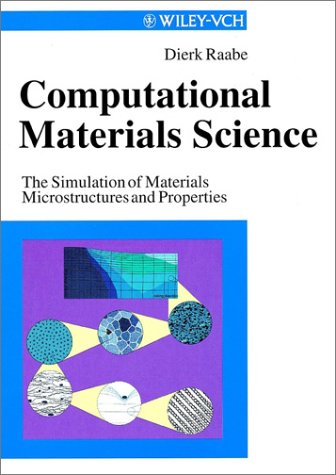Nathan Ida, Joao P.A. Bastos0387948775, 9780387948775
Table of contents :
Cover ……Page 1
Springer ……Page 2
Title page ……Page 3
Date-line ……Page 4
Preface ……Page 5
Contents ……Page 9
1.2. The Vector Notation ……Page 18
1.3.2. Definition of the Gradient, Divergence, and Curl ……Page 19
1.4. The Gradient ……Page 20
1.4.1. Example of Gradient ……Page 22
1.5.1. Definition of Flux ……Page 23
1.5.2. The Divergence Theorem ……Page 25
1.5.3. Conservative Flux ……Page 26
1.5.4. Example of Divergence ……Page 28
1.6.1. Circulation of a Vector ……Page 29
1.6.2. Stokes’ Theorem ……Page 31
1.6.3. Example of Curl ……Page 34
1.7. Second Order Operators ……Page 35
1.8. Application of Operators to More than One Function ……Page 36
1.9. Expressions in Cylindrical and Spherical Coordinates ……Page 37
2.2. Maxwell’s Equations ……Page 39
2.2.1. Fundamental Physical Principles of the Electromagnetic Field ……Page 40
2.2.2. Point Form of the Equations ……Page 46
2.2.3. The Equations in Vacuum ……Page 49
2.2.4. The Equations in Media with $varepsilon=varepsilon_0$ and $mu=mu_0$ ……Page 51
2.2.5. The Equations in General Media ……Page 52
2.2.6. The Integral Form of Maxwell’s Equations ……Page 54
2.3. Approximations to Maxwell’s Equations ……Page 60
2.4. Units ……Page 62
3.2. The Electrostatic Charge ……Page 64
3.2.2. Force on an Electric Charge ……Page 65
3.2.3. The Electric Scalar Potential $V$ ……Page 66
3.3. Nonconservative Fields: Electromotive Force ……Page 70
3.4. Refraction of the Electric Field ……Page 72
3.5. Dielectric Strength ……Page 76
3.6.1. Definition of Capacitance ……Page 78
3.6.3. Energy in a Static, Conservative Field ……Page 81
3.7. Laplace’s and Poisson’s Equations in Terms of the Electric Field ……Page 82
3.8.1. The Infinite Charged Line ……Page 84
3.8.2. The Charged Spherical Half-Shell ……Page 87
3.8.3. The Spherical Capacitor ……Page 88
3.8.4. The Spherical Capacitor with Two Dielectric Layers ……Page 89
3.9. A Brief Introduction to the Finite Element Method: Solution of the Two-Dimensional Laplace Equation ……Page 91
3.9.1. The Finite Element Technique for Division of a Domain ……Page 92
3.9.2. The Variational Method ……Page 94
3.9.3. A Finite Element Program ……Page 97
3.9.4. Example for Use of the Finite Element Program ……Page 101
3.10. Tables of Permittivities, Dielectric Strength, and Conductivities ……Page 105
4.1. Introduction ……Page 107
4.2.1. The Equation $nablatimesmathbf{H}=mathbf{J}$ ……Page 108
4.2.3. The Equation $nablatimesmathbf{E}=0$ ……Page 110
4.3. The Biot-Savart Law ……Page 111
4.4. Boundary Conditions for the Magnetic Field ……Page 113
4.5. Magnetic Materials ……Page 115
4.5.1. Diamagnetic Materials ……Page 116
4.5.3. Ferromagnetic Materials ……Page 117
4.5.4. Permanent Magnets ……Page 121
4.6. The Analogy between Magnetic and Electric Circuits ……Page 132
4.7.1. Definition of Inductance ……Page 136
4.7.2. Energy in a Linear System ……Page 137
4.7.3. The Energy Stored in the Magnetic Field ……Page 139
4.8.1. Calculation of Field Intensity and Inductance of a Long Solenoid ……Page 140
4.8.2. Calculation of H for a Circular Loop ……Page 142
4.8.3. Field of a Rectangular Loop ……Page 144
4.8.4. Calculation of Inductance of a Coaxial Cable ……Page 145
4.8.5. Calculation of the Field Inside a Cylindrical Conductor ……Page 146
4.8.6. Calculation of the Magnetic Field Intensity in a Magnetic Circuit ……Page 147
4.8.7. Calculation of the Magnetic Field Intensity of a Saturated Magnetic Circuit ……Page 150
4.8.8. Magnetic Circuit Incorporating Permanent Magnets ……Page 152
4.9. Laplace’s Equation in Terms of the Magnetic Scalar Potential ……Page 155
4.10. Properties of Soft Magnetic Materials ……Page 157
5.1. Introduction ……Page 159
5.2. Maxwell’s Equations for the Magnetodynamic Field ……Page 160
5.3.1. The Equation for $mathbf{H}$ ……Page 163
5.3.3. The Equation for $mathbf{E}$ ……Page 164
5.3.5. Solution of the Equations ……Page 165
5.4. Eddy Current Losses in Plates ……Page 170
5.5. Hysteresis Losses ……Page 173
5.6.1. Induced Currents Due to Change in Induction ……Page 177
5.6.2. Induced Currents Due to Changes in Geometry ……Page 180
5.6.3. Inductive Heating of a Conducting Block ……Page 182
5.6.4. Effect of Movement of a Magnet Relative to a Flat Conductor ……Page 186
5.6.5. Visualization of Penetration of Fields as a Function of Frequency ……Page 188
5.6.6. The Voltage Transformer ……Page 189
6.2. Force on a Conductor ……Page 192
6.3. Force on Moving Charges: The Lorentz Force ……Page 195
6.4. Energy in the Magnetic Field ……Page 197
6.5. Force as Variation of Energy (Virtual Work) ……Page 199
6.6. The Poynting Vector ……Page 201
6.7. Maxwell’s Force Tensor ……Page 205
6.8.1. Force between Two Conducting Segments ……Page 212
6.8.2. Torque on a Loop ……Page 215
6.8.3. The Hall Effect ……Page 217
6.8.4. The Linear Motor and Generator ……Page 219
6.8.5. Attraction of a Ferromagnetic Body ……Page 222
6.8.6. Repulsion of a Diamagnetic Body ……Page 223
6.8.7. Magnetic Levitation ……Page 224
6.8.8. The Magnetic Brake ……Page 226
7.1. Introduction ……Page 229
7.2.1. The Time Dependent Equations ……Page 232
7.2.2. The Time Harmonic Wave Equations ……Page 237
7.2.4. Solution for Plane Waves ……Page 239
7.2.5. The One-Dimensional Wave Equation in Free Space and Lossless Dielectrics ……Page 240
7.3 1. Propagation of Waves in Lossy Dielectrics ……Page 244
7.3.2. Propagation of Plane Waves in Low-Loss Dielectrics : ……Page 246
7.3.3. Propagation of Plane Waves in Conductors ……Page 247
7.3.4. Propagation in a Conductor: Definition of the Skin Depth ……Page 249
7.4. Polarization of Plane Waves ……Page 250
7.5. Reflection, Refraction, and Transmission of Plane Waves ……Page 252
7.5.1. Reflection and Transmission at a Lossy Dielectric Interface: Normal Incidence ……Page 253
7.5.2. Reflection and Transmission at a Conductor Interface: Normal Incidence ……Page 256
7.5.3. Reflection and Transmission at a Finite Conductivity Conductor Interface ……Page 257
7.5.4. Reflection and Transmission at an Interface: Oblique Incidence ……Page 258
7.5.5. Oblique Incidence on a Conducting Interface: Perpendicular Polarization ……Page 259
7.5.6. Oblique Incidence on a Conducting Interface: Parallel Polarization ……Page 261
7.5.7. Oblique Incidence on a Dielectric Interface: Perpendicular Polarization ……Page 262
7.5.8. Oblique Incidence on a Dielectric Interface: Parallel Polarization ……Page 265
7.6.1. TEM,TE, and TM Waves ……Page 266
7.6.3. TEWaves ……Page 268
7.6.4. TMWaves ……Page 269
7.6.6. TM Modes in Waveguides ……Page 270
7.6.7. TE Modes in Waveguides ……Page 273
7.7. Cavity Resonators ……Page 275
7.7.1. TM and TE Modes in Cavity Resonators ……Page 276
7.7.3. Energy in a Cavity ……Page 278
7.7.5. Coupling to Cavities ……Page 280
8.1. Introduction ……Page 282
8.2. The Galerkin Method – Basic Concepts ……Page 283
8.3. The Galerkin Method – Extension to 2D ……Page 294
8.3.1. The Boundary Conditions ……Page 295
8.3.2. Calculation of the 2D Elemental Matrix ……Page 296
8.4. The Variational Method – Basic Concepts ……Page 298
8.5.1. The Variational Formulation ……Page 301
8.5.2. Calculation of the 2D Elemental Matrix ……Page 306
8.6. Generalization of the Finite Element Method ……Page 308
8.6.1. High-Order Finite Elements: General ……Page 309
8.6.2. High-Order Finite Elements: Notation ……Page 310
8.6.3. High-Order Finite Elements: Implementation ……Page 313
8.6.5. Polynomial Basis ……Page 315
8.6.6. Transformation of Quantities – the Jacobian ……Page 317
8.6.7. Evaluation of the Integrals ……Page 319
8.7.1. Evaluation of the Integrals ……Page 323
8.7.2. Basic Principles of Numerical Integration ……Page 324
8.7.3. Accuracy and Errors in Numerical Integration ……Page 328
8.8. Some Specific Finite Elements ……Page 330
8.8.1. ID Elements ……Page 331
8.8.2. 2D Elements ……Page 332
8.8.3. 3D Elements ……Page 335
8.9.1. Coupling Different Types of Finite Elements ……Page 340
8.9.2. Infinite Elements ……Page 342
8.10.1. The Stiffness Matrix ……Page 344
8.10.3. Evaluation of the Third Term in Eq. (8.130) ……Page 346
8.11.1. The Problem to Be Solved ……Page 347
8.11.2. The Discretized Domain ……Page 349
8.11.3. The Finite Element Program ……Page 350
9.2.1. Electrostatic Fields: Dielectric Materials ……Page 360
9.2.2. Stationary Currents: Conducting Materials ……Page 362
9.2.3. Magnetic Fields: Scalar Potential ……Page 363
9.2.4. The Magnetic Field: Vector Potential ……Page 364
9.2.5. The Electric Vector Potential ……Page 369
9.3. The Variational Method ……Page 370
9.3.1. The Variational Formulation ……Page 371
9.3.2. Functional Involving Scalar Potentials ……Page 372
9.3.3. The Vector Potential Functional ……Page 376
9.4. The Finite Element Method ……Page 379
9.5. Application of Finite Elements with the Variational Method ……Page 383
9.5.1. Application to the Electrostatic Field ……Page 384
9.5.3. Application to the Magnetic Field: Scalar Potential ……Page 387
9.5.4. Application to the Magnetic Field: Vector Potential ……Page 388
9.6. Assembly of the Matrix System ……Page 390
9.7. Axi-Symmetric Applications ……Page 392
9.8.1. Method of Successive Approximation ……Page 400
9.8.2. The Newton-Raphson Method ……Page 401
9.9. The Three-Dimensional Scalar Potential ……Page 404
9.9.1. The First-Order Tetrahedral Element ……Page 405
9.9.3. Modeling of 3D Permanent Magnets ……Page 406
9.10. Examples ……Page 407
9.10.1. Calculation of Electrostatic Fields ……Page 408
9.10.2. Calculation of Static Currents ……Page 409
9.10.3. Calculation of the Magnetic Field: Scalar Potential ……Page 411
9.10.4. Calculation of the Magnetic Field: Vector Potential ……Page 413
9.10.5. Three-Dimensional Calculation of Fields of Permanent Magnets ……Page 415
10.1. Introduction ……Page 417
10.2. Application to Magnetic Fields in Anisotropic Media ……Page 418
10.3.1. First-Order Element in Local Coordinates ……Page 422
10.3.2. The Vector Potential Equation Using Time Discretization ……Page 426
10.3.3. The Complex Vector Potential Equation ……Page 434
10.3.4. Structures with Moving Parts ……Page 437
10.3.5. The Axi-Symmetric Formulation ……Page 439
10.3.6. A Modified Complex Vector Potential Formulation for Wave Propagation ……Page 442
10.3.7. Formulation of Helmholtz’s Equation ……Page 444
10.3.8. Advantages and Limitations of 2D Formulations ……Page 447
10.4. Application of the Newton-Raphson Method ……Page 449
10.5.1. Eddy Currents: Time Discretization ……Page 451
10.5.2. Moving Conducting Piece in Front of an Electromagnet ……Page 454
10.5.3. Modes and Fields in a Waveguide ……Page 457
10.5.4. Resonant Frequencies of a Microwave Cavity ……Page 459
11.1. Introduction ……Page 462
11.2. The Hexahedral Edge Element Shape Functions ……Page 465
11.3. Construction of the Shape Functions ……Page 473
11.4. Application of Edge Elements to Low-Frequency Maxwell’s Equations ……Page 477
11.4.1. Static Cases ……Page 478
11.4.2. Listing of the Matrix Construction Code ……Page 481
11.4.4. Eddy Currents – the Time-Stepping Procedure ……Page 483
11.4.5. Eddy Currents – The Complex Formulation ……Page 485
11.4.6. The Newton-Raphson Method ……Page 486
11.4.7. The Divergence of J and Other Particulars ……Page 488
11.5. Modeling of Waveguides and Cavity Resonators ……Page 489
11.6. Examples ……Page 490
11.6.1. Static Calculations (TEAM Problem 13) ……Page 491
11.6.2. A Linear Motor with Permanent Magnets ……Page 492
11.6.3. Eddy Current Calculations (TEAM Problem 21) ……Page 494
11.6.4. Calculation of Resonant Frequencies (TEAMProblem 19) ……Page 497
12.2.1. Periodicity ……Page 501
12.2.2. Anti-Periodicity ……Page 503
12.3.2. The Banded Matrix and Its Storage ……Page 504
12.3.3. Compact Storage of the Matrix ……Page 506
12.4. Insertion of Dirichlet Boundary Conditions ……Page 507
12.5. Quadrilateral and Hexahedral Elements ……Page 508
12.6.1. Direct Methods ……Page 510
12.6.2. Iterative Methods ……Page 514
12.7.1. The Jacobi Transformation ……Page 517
12.7.2. The Givens Transformation ……Page 520
12.7.3. The QR and QZ Methods ……Page 521
12.8. Diagram of a Finite Element Program ……Page 523
13.1. Introduction ……Page 526
13.2.1. The User/System Dialogue ……Page 527
13.2.2. Domain Discretization ……Page 528
13.3. The Processor Module ……Page 533
13.4.1. Visualization of Results ……Page 534
13.4.2. Calculation of Numerical Results ……Page 536
13.5. The Computational Organization of a Software Package ……Page 541
13.5.1. The EFCAD Software ……Page 542
13.6.1. The Adaptive Mesh Method ……Page 545
13.6.2. A Coupled Thermal/Electrical System ……Page 550
13.6.3. A Software Package for Electrical Machines ……Page 554
13.6.4 A System for Simultaneous Solution of Field Equations and External Circuits ……Page 558
13.7. Recent Trends ……Page 564
Bibliography ……Page 566
Subject Index ……Page 576
Back Cover ……Page 583







Reviews
There are no reviews yet.